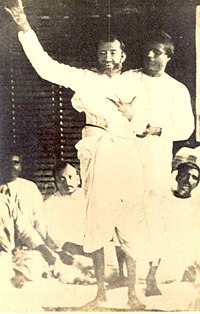Kalinath Bose
Kalinath Bose (Bengali: কালীনাথ বোস) was the first Indian to be promoted as Superintendent of Police under the British administration in March 1881.[1] One of the early Indians to be operating in the intelligence branch of the police he was rewarded in 1875 for recovering the crown jewels of the Maharaja of Travancore.[2] That was a daring feat he accomplished by going into the den of dacoits in the deep forests in the guise of a woman. He had performed many other daring acts during his service career.

Bosepara Lane house[edit]
He belonged to a renowned family in Bosepara Lane in Bagbazar, Kolkata. His father Lokenath Bose was associated with the British judiciary. He was born around 1840. The family had deep religious affiliations. Ramakrishna Paramhamsadev visited their ancestral house at Bosepara Lane in 1877.
There is a tablet in Bengali at the Bosepara Lane house, which reads, "Dinanath Bose, elder brother of Kalinath Bose, mentioned in the Kathamrita, honourably received Sri Ramkrishnadev on the first floor of his north Kolkata house no. 40 (baghwala bari – the house with the tiger) presently 47B Bosepara Lane (Ma Saradamani Sarani) in 1877. It was probably the first auspicious visit of Thakur to a house in North Kolkata. Many young people gathered to have his blessings. Amongst them mention may be made of Harinath Chaterjee (later Swami Turiyananda), Gangadhar Ghatak (Gangopadhyay) (later Swami Akhandanada) and Girish Chandra Ghosh. This is the first house in Baghbazar to be blessed with the footsteps of Sri Ramkrishnadev." The tablet was placed there by people of the locality.
Life sketch[edit]
Kalinath Bose had joined the Brahmo Samaj and Kathamrita mentions him as a friend and devotee (bhakta-bandhu) of Keshub Chunder Sen.[3] He used to be present when the latter went to meet Ramakrishna Paramhamsadev for religious discussions.
He married Kumudini of the Rambagan Dutt family. She was a cousin of Romesh Chunder Dutt.
Their eldest daughter, Saratkumari, was married to Satyapriya Deb, son of Sib Chandra Deb in what was a memorable marriage in 1876 (see Sib Chandra Deb for details). Two of his daughters were married to two sons of the Brahmo missionary Dinanath Mozumdar. Subsequently, his son, Upendranath Bose, married one of the daughters of Dinanath Mozumdar.
He died rather young around 1883.
